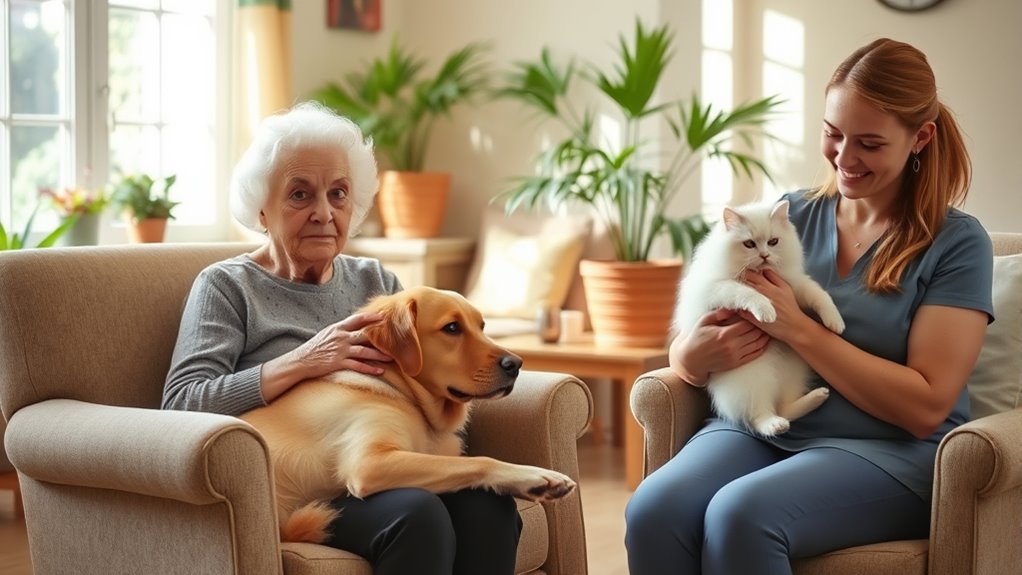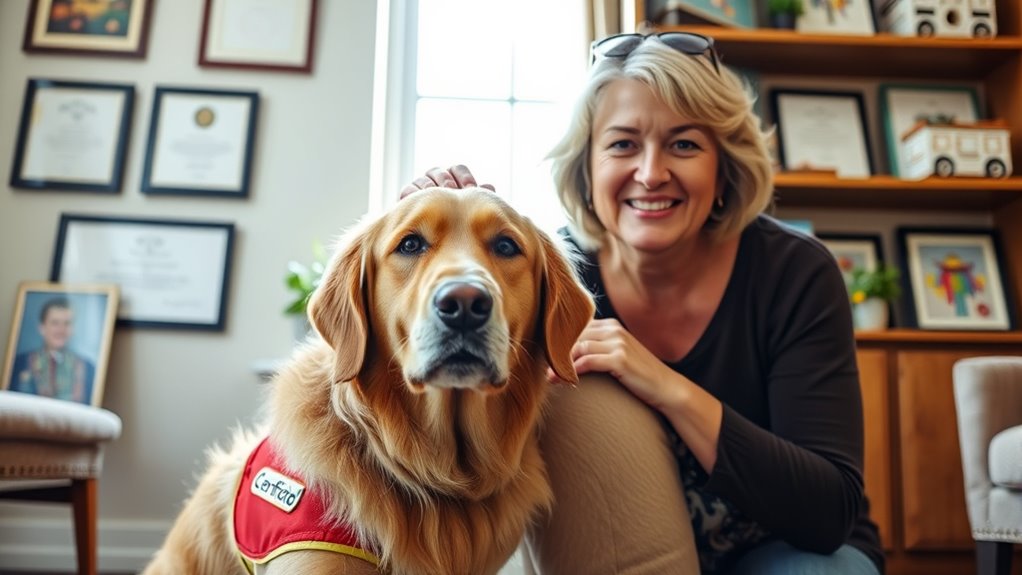Pet therapy involves animals like dogs and horses visiting you to provide emotional support and reduce stress. When you interact with therapy animals, your body releases happy chemicals like oxytocin and dopamine, helping you feel calm and less anxious. These animals also help decrease loneliness and improve social skills. Properly trained and certified animals guarantee safety and effectiveness. If you want to discover how this therapy can boost your mental health, keep going to learn more.
Key Takeaways
- Pet therapy involves trained animals providing emotional support to improve mental health and reduce stress.
- Interacting with therapy animals releases chemicals like oxytocin and dopamine, promoting happiness and relaxation.
- Pet therapy helps lower cortisol levels, decreasing anxiety, depression, and feelings of loneliness.
- Animals in therapy foster emotional expression, social skills, and emotional regulation in various settings.
- Certified therapy animals create calming environments that support mental well-being and emotional resilience.
Understanding Animal-Assisted Therapy and Its Purpose

Have you ever wondered how animals can help people recover emotionally? Animal-assisted therapy involves trained animals, like dogs or horses, visiting patients to provide emotional support and aid recovery.
The main goal of this therapy is to improve mental health by reducing stress, fostering emotional expression, and boosting social skills. Therapy animals are carefully selected, trained, and certified to ensure they’re calm, safe, and suitable for therapeutic settings.
This approach supports a variety of mental health conditions, including depression, anxiety, PTSD, and autism spectrum disorders.
How Pet Interactions Promote Emotional Well-being

Interactions with pets can profoundly boost your emotional well-being by triggering the release of chemicals like oxytocin, serotonin, and dopamine, which promote feelings of happiness and relaxation. These animal interactions lower cortisol levels and blood pressure, helping you feel calmer and less stressed. Color accuracy in the animals’ appearance and behavior can also enhance your emotional response. Engaging with animals also encourages emotional openness and expression, making it easier to process your feelings. Plus, the presence of pets during interactions reduces loneliness and social isolation, strengthening your emotional resilience. When you spend time with animals, you create a sense of connection and safety that supports your mental health. Proper care and attention to pets can further amplify these psychological benefits, fostering a positive feedback loop. Additionally, incorporating remote work practices can facilitate more flexible and consistent interaction times with your pets, enhancing these benefits. Regular interactions with animals also have the potential to promote digital literacy among seniors, making digital communication more playful and engaging. Incorporating community programs that facilitate pet visits can further expand these benefits. To maximize these benefits, consider: 1. Spending quality time with your pet daily. 2. Practicing physical contact to enhance stress reduction. 3. Engaging in playful activities to boost mood. 4. Using animal interactions to foster emotional openness.
The Role of Therapy Animals in Reducing Stress and Anxiety

Ever wonder how therapy animals help alleviate stress and anxiety? When you interact with therapeutic animals, your body releases hormones like oxytocin, endorphins, and dopamine, which lower stress and boost your mood. Engaging in mindfulness activities during animal interactions can further enhance relaxation and emotional regulation. Petting and cuddling these animals decrease cortisol levels, helping you relax during tense moments. The presence of therapy animals during stressful situations, such as exams or medical procedures, can markedly reduce your perceived anxiety. In healthcare settings, visits from therapeutic animals are linked to measurable drops in blood pressure and heart rate, indicating reduced stress. These benefits are often amplified when animals are trained to provide emotional support, making the interactions even more therapeutic. Structured interactions with therapeutic animals support emotional regulation, making it easier for you to manage feelings of stress and anxiety more effectively. Recognizing behavioral responses of therapy animals can further improve your comfort and the effectiveness of these interactions. Incorporating mindfulness techniques into your interactions can deepen the calming effects and promote present-moment awareness. Additionally, understanding the benefits of trained animals helps maximize the positive impact on mental health. These animals truly serve as natural stress-relievers in your mental health journey.
Benefits of Pet Therapy for Children and Adolescents

Pet therapy offers significant benefits for children and adolescents by creating a calming environment that encourages openness and reduces anxiety. Therapy animals help children communicate more freely and feel less fearful during sessions. Interacting with animals can boost kids’ speech and literacy skills by motivating participation and easing communication barriers. Children with developmental and neurological conditions, like autism, often show increased social engagement and emotional expression through pet therapy. Additionally, therapy animals help children feel calmer and more relaxed during medical exams, making cooperation easier. Engaging with therapy animals also lowers stress hormones like cortisol, promoting better emotional regulation and overall mental health. Moreover, research indicates that pet therapy can positively influence mental health by reducing feelings of loneliness and fostering a sense of companionship, which is crucial for emotional resilience. These benefits highlight how therapy animals support children’s emotional well-being, fostering growth and resilience. Furthermore, the presence of animals can reduce anxiety associated with unfamiliar environments, enhancing the effectiveness of therapy sessions.
Physical Health Improvements Through Animal-Assisted Activities

Engaging with therapy animals can lead to significant improvements in physical health, as it stimulates the release of endorphins that help lower blood pressure and ease pain. Animal-assisted activities encourage you to move, pet, and interact, which promotes relaxation and better cardiovascular health. These activities motivate you to participate more actively in physical therapy, aiding faster recovery of motor skills. Petting and playing with animals increase oxytocin levels, supporting your immune function and reducing stress. Regular visits from therapy animals are linked to decreased cortisol levels, a hormone associated with stress, ultimately enhancing your overall physical health. Additionally, many air purifier models utilize advanced filtration technologies that can further improve indoor air quality, supporting respiratory health during recovery. The use of vetted animal-assisted therapies ensures safety and effectiveness, maximizing health benefits. These interactions not only boost your mood but also contribute to tangible physical health benefits, making animal-assisted activities a valuable complement to your wellness routine.
Incorporating Animals Into Mental Health Treatment Plans

Incorporating animals into mental health treatment plans can substantially enhance emotional expression and strengthen the connection between clients and therapists. Therapy animals facilitate structured activities like reflection or guided interactions, supporting social skills and emotional regulation. Automation technology is increasingly being used to support mental health services, helping to monitor progress and tailor interventions more effectively. You’ll notice therapists often observe spontaneous interactions with therapy animals to better understand your emotional state, allowing for tailored interventions. Proper training and certification of therapy animals ensure safety, effectiveness, and ethical integration into mental health settings. Including animals in your treatment can boost motivation, reduce anxiety, and create a sense of trust and safety. Incorporating state-specific regulations can help ensure that therapy animals are legally and ethically integrated into treatment plans. Additionally, understanding animal behavior can improve the safety and effectiveness of these interactions. To make the most of incorporating animals, consider these steps:
- Work with trained therapy animals approved for mental health settings
- Engage in structured activities with your therapy animal
- Share reflections during interactions
- Collaborate with your therapist to personalize your approach
Safety and Best Practices for Pet Therapy Sessions

To guarantee safe and effective pet therapy sessions, it’s essential to follow established best practices. Handwashing before and after each session helps prevent the spread of germs, protecting both participants and animals. Regular health screenings and vaccinations ensure the therapy animals stay in good health and free of contagious diseases. Monitoring animal behavior allows you to recognize signs of stress or discomfort, preventing injuries or behavioral issues. Limiting session duration to around 15 minutes helps reduce fatigue and keeps animals comfortable. Additionally, maintaining a controlled environment with safe resting spaces minimizes injury risks and promotes a positive experience. Incorporating body awareness practices can help handlers better understand and respond to animals’ non-verbal cues during sessions. Ensuring compliance with Gold IRA regulations and standards can also contribute to a safer and more structured therapy setting. Using performance cookies to analyze session flow can provide insights into optimizing the environment and handling techniques for better safety. Paying attention to safety protocols is crucial for minimizing risks and ensuring a secure experience for everyone involved. Incorporating regular training sessions for handlers can further improve safety and responsiveness during therapy interactions.
The Growing Use of Therapy Dogs in Educational Settings

You might notice how therapy dogs help create a calmer classroom atmosphere, making it easier for students to focus and reduce anxiety.
Their presence also encourages better engagement and positive social interactions among peers.
Additionally, therapy dogs offer valuable support for students with disabilities, improving communication and emotional regulation.
Research shows that instant torque can further enhance the calming effects and foster a more relaxed environment in educational settings.
Calming Classroom Environment
As more schools recognize the benefits of therapy dogs, their presence in classrooms is becoming a popular strategy to create a calming environment. Therapy dogs help reduce student anxiety and fear, making the classroom feel more relaxed. They promote stress reduction by lowering cortisol levels, which helps students stay calmer and more focused. Additionally, incorporating therapy animals into educational settings can enhance overall emotional resilience among students. Here are four ways therapy dogs contribute to a calming environment:
- They ease anxiety, encouraging students to participate more comfortably.
- Interactions with therapy dogs boost social interactions among students.
- Their calming presence decreases behavioral issues.
- Students experience improved focus and engagement during lessons.
Incorporating therapy dogs into classrooms not only supports mental well-being but also fosters a peaceful, productive learning space for everyone.
Enhancing Student Engagement
The presence of therapy dogs in classrooms has become an effective way to boost student engagement and participation. Therapy animals create a calming environment that reduces anxiety and stress, making students more receptive to learning.
When therapy dogs are present, students tend to focus better, show increased interest, and interact more with peers and teachers. This heightened engagement leads to improved classroom behavior and academic performance.
Schools incorporating therapy animals report fewer disruptions and better emotional well-being among students, especially those with disabilities. As this trend grows, research continues to highlight how therapy dogs support mental health and foster a positive learning atmosphere.
Supporting Special Needs
How are therapy dogs transforming support for students with special needs? They create a calming environment that reduces stress and anxiety, which is essential for mental health. Therapy dogs also boost engagement and help improve classroom behavior, especially for students with disabilities.
The trend of incorporating therapy dogs in schools has grown rapidly, emphasizing social-emotional development and behavioral health.
Consider these benefits:
- They facilitate communication and social interactions for shy or anxious students.
- Therapy dogs support emotional regulation and well-being.
- They encourage participation and build confidence.
- Certified therapy dogs help foster academic success in diverse learning environments.
Training and Certification for Therapy Animals and Handlers

To guarantee therapy animals and their handlers are prepared, certification programs set clear standards that include temperament tests, health checks, and obedience assessments.
You’ll also need to complete specialized training that covers animal behavior, safety, and legal considerations.
Understanding these requirements helps you provide safe, effective support in diverse settings.
Certification Requirements and Standards
Certification requirements and standards guarantee that therapy animals and their handlers are properly prepared to provide safe and effective support. To achieve certification, you’ll need to undergo assessments of your animal’s temperament, obedience, and health, confirming it’s suitable for therapeutic work.
Recognized organizations like Pet Partners and the American Kennel Club set strict standards, including regular evaluations and ongoing education. You must also meet certain health requirements, such as up-to-date vaccinations and behavioral testing, to prevent disease transmission.
Additionally, handlers need to adhere to legal and ethical guidelines, including liability insurance and proper documentation. Certification assures everyone involved maintains high standards, fostering trust and safety in pet therapy programs.
- Animal temperament and health assessments
- Handler training and safety protocols
- Adherence to recognized certification standards
- Ongoing evaluations and education
Training Techniques and Methods
Effective training techniques are essential to preparing therapy animals and their handlers for successful therapeutic interactions. Recognized programs emphasize positive reinforcement, like treats and praise, to encourage desirable behaviors. Training covers obedience, socialization, and stress management, ensuring safety and effectiveness. Handlers must complete coursework on legal regulations, health protocols, and ethics. Specialized training exposes animals to various environments, helping them stay calm and adaptable. Certification requires ongoing assessments and recertification, maintaining the therapy animal’s suitability. The table below highlights key training aspects:
| Aspect | Focus | Method |
|---|---|---|
| Behavior Training | Obedience and socialization | Positive reinforcement |
| Stress Management | Calmness in varied settings | Exposure techniques |
| Certification Process | Ongoing assessments | Recertification |
Handler Qualifications and Responsibilities
Ensuring that therapy animal handlers are properly qualified is essential for safe and successful therapeutic interactions. Proper certification and training equip you with the skills needed to support your animal and clients effectively.
- Complete specialized training programs that cover animal behavior, safety, and legal rights.
- Obtain certification through recognized organizations to demonstrate your competence.
- Regularly assess and maintain your animal’s temperament, health, and obedience.
- Participate in ongoing education to stay current with best practices and regulations.
These steps help ensure that you, as a handler, are prepared to manage your therapy animal responsibly, creating a safe environment for everyone involved. Certification and training are the foundation of effective pet therapy work.
Resources and Opportunities for Engaging in Pet Therapy

Are you interested in exploring pet therapy opportunities? Many organizations, like Pet Partners and Husson University, offer certification and training programs for aspiring therapy animal handlers. These programs equip you with the skills needed to work with therapy animals in hospitals, schools, or rehab centers.
Explore pet therapy with programs from Pet Partners and Husson University to become a certified therapy animal handler.
Volunteering at animal shelters or rescue groups is another way to experience pet therapy firsthand and contribute to your community.
Resources like the HEMHA “Animals on Campus Guide” provide practical advice for integrating therapy animals into educational settings.
To get started, contact local training institutions or organizations such as Husson University at 1 College Circle, Bangor, ME, 207.992.1972. These resources make it easier to find certification programs and volunteer opportunities tailored to your interests.
Frequently Asked Questions
How Do Therapy Animals Help With Mental Health?
You might wonder how therapy animals help with mental health. When you interact with them, they encourage you to share feelings you might hide, making emotional expression easier.
Their presence boosts hormones like oxytocin and serotonin, reducing stress and anxiety. Plus, they create a calming environment, lessen loneliness, and foster social bonds.
What Is the Role of Animals in Therapy and Rehabilitation?
In therapy and rehabilitation, animals play an essential role by offering emotional comfort and reducing stress.
You’ll find that their presence encourages social interaction and communication, especially if you struggle with mental health or social difficulties.
They motivate physical movement, help you express emotions, and create a calming environment.
What Is the Therapeutic Use of Animals?
You might wonder what the therapeutic use of animals involves. It means using trained animals, like dogs or horses, to support mental health treatment. These animals help you communicate better, lower your stress, and encourage social interaction.
When they’re present, they release hormones that boost your mood and reduce anxiety. This approach can be especially helpful if you’re dealing with depression, anxiety, PTSD, or autism.
What Types of Animals Are Used in Animal-Assisted Therapy?
You might be surprised to learn that many animals are used in therapy to support mental health. Dogs are the most common because of their friendly nature and trainability.
Horses help promote emotional regulation.
Cats provide calming presence, reducing anxiety.
Small mammals like rabbits and guinea pigs are gentle and easy to handle, especially with children.
In some cases, dolphins and llamas are employed for their unique behaviors and interactions.
Conclusion
Did you know that therapy animals can reduce stress levels by up to 24%? As you see, pet therapy offers powerful emotional and physical benefits, helping people of all ages improve their mental health. Whether you’re considering volunteering or simply want to bring a pet into your life, understanding these positive impacts can inspire you to make a difference. Embrace the healing power of animals—you might just find your own path to greater well-being.









